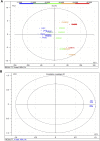In-Vitro α-amylase, α-glucosidase Inhibitory Activities and In-Vivo Anti-Hyperglycemic Potential of Different Dosage Forms of Guduchi (Tinospora Cordifolia [Willd.] Miers) Prepared With Ayurvedic Bhavana Process
- PMID: 34040519
- PMCID: PMC8141809
- DOI: 10.3389/fphar.2021.642300
In-Vitro α-amylase, α-glucosidase Inhibitory Activities and In-Vivo Anti-Hyperglycemic Potential of Different Dosage Forms of Guduchi (Tinospora Cordifolia [Willd.] Miers) Prepared With Ayurvedic Bhavana Process
Abstract
Guduchi (Tinospora cordifolia [Willd.] Miers) is a flagship rejuvenating herb of Ayurveda with reported anti-diabetic potential. In the present study, different dosage forms of Guduchi stem (growing on neem tree) were developed by adopting Ayurvedic pharmaceutical process of Bhavana (levigation). Guduchi Churna (GC) was subjected to 07 times Bhavana separately with its own extracted juice, decoction and potable water, and dosage forms namely Svarasa Bhavita Guduchi Churna (SBGC), Kwatha Bhavita Guduchi Churna (KBGC), and Jala Bhavita Guduchi Churna (JBGC) were prepared. The present study was aimed to evaluate the role of Bhavana on the potentiation of therapeutic properties of Guduchi. Sequential solvent extracts (5, 10, 15 and 25%) of GC, SBGC, KBGC and JBGC were prepared in different solvents [phosphate buffer, hexane, dichloromethane (DCM), chloroform] and screened for the α-amylase and α-glucosidase inhibitory activity. The results revealed that phosphate buffer and DCM extracts of SBGC exhibited strong α-amylase inhibitory potential (>80% inhibition at 25% concentration) followed by KBGC, JBGC and GC with reference to the standard acarbose. In α-glucosidase inhibitory activity, maximum inhibition was observed in DCM and chloroform extracts of SBGC (>85% inhibition at 25% concentration), followed by KBGC (>80% inhibition at 25% concentration), JBGC and GC. In vivo anti-hyperglycemic studies were carried out by oral glucose tolerance test in Swiss albino mice. Test drugs (JBGC, KBGC, SBGC) treated groups showed marginal decrease of blood glucose levels in normo glycemic mice. However, the blood glucose level in test drug JBGC, KBGC and SBGC treated groups was still within normal range in overnight fasted mice. In oral glucose tolerance test, among all dosage forms SBGC (51.08%) produced pronounced anti-hyperglycemic effect followed by KBGC (42.57%) at a dose of 520 mg/kg. The GC, JBGC, KBGC and SBGC samples were also standardized using berberine (a well established anti-diabetic compound) as a marker compound by HPTLC fingerprint analysis. Findings of the present study indicate that SBGC and KBGC can be used in the treatment of diabetes mellitus and gives supporting evidence to Ayurvedic claims that the Bhavana process has pharmaceutico-therapeutic significance in Ayurvedic drug development.
Keywords: anti-hyperglycemic; bhavana; guduchi; hypoglycemic; tinospora cordifolia; α-amylase; α-glucosidase.
Copyright © 2021 Sharma, Bolleddu, Maji, Ruknuddin and Prajapati.
Conflict of interest statement
The authors declare that the research was conducted in the absence of any commercial or financial relationships that could be construed as a potential conflict of interest.
Figures








Similar articles
-
Hypoglycemic and anti-hyperglycemic activity of Guduchi Satva in experimental animals.Ayu. 2013 Oct;34(4):417-20. doi: 10.4103/0974-8520.127726. Ayu. 2013. PMID: 24695802 Free PMC article.
-
Comparative immunomodulation potential of Tinospora cordifolia (Willd.) Miers ex Hook. F., Tinospora sinensis (Lour.) Merrill and Tinospora cordifolia growing on Azadirachta indica A. Juss.Indian J Exp Biol. 2014 Aug;52(8):808-13. Indian J Exp Biol. 2014. PMID: 25141544
-
A comparative pharmacological evaluation of Taila (oil) and Ghrita (ghee) prepared with Guduchi (Tinospora cordifolia).Ayu. 2010 Oct;31(4):504-8. doi: 10.4103/0974-8520.82036. Ayu. 2010. PMID: 22048548 Free PMC article.
-
Can Guduchi (Tinospora cordifolia), a well-known ayurvedic hepato-protectant cause liver damage?J Ayurveda Integr Med. 2023 Jan-Feb;14(1):100658. doi: 10.1016/j.jaim.2022.100658. Epub 2022 Nov 16. J Ayurveda Integr Med. 2023. PMID: 36400639 Free PMC article. Review.
-
Using Guduchi (Tinospora cordifolia) as an eco-friendly feed supplement in human and poultry nutrition.Poult Sci. 2020 Feb;99(2):801-811. doi: 10.1016/j.psj.2019.10.051. Epub 2019 Nov 29. Poult Sci. 2020. PMID: 32029162 Free PMC article. Review.
Cited by
-
Regulation of Insulin Resistance, Lipid Profile and Glucose Metabolism Associated with Polycystic Ovary Syndrome by Tinospora cordifolia.Nutrients. 2023 May 9;15(10):2238. doi: 10.3390/nu15102238. Nutrients. 2023. PMID: 37242122 Free PMC article.
-
Evaluation of the Antidiabetic Potential of Xanthone-Rich Extracts from Gentiana dinarica and Gentiana utriculosa.Int J Mol Sci. 2024 Aug 21;25(16):9066. doi: 10.3390/ijms25169066. Int J Mol Sci. 2024. PMID: 39201752 Free PMC article.
-
Network pharmacology, molecular docking, and molecular dynamics simulation to elucidate the mechanism of anti-aging action of Tinospora cordifolia.Mol Divers. 2024 Jun;28(3):1743-1763. doi: 10.1007/s11030-023-10684-w. Epub 2023 Jul 13. Mol Divers. 2024. PMID: 37439907 Review.
-
Epigenetics in obesity: Mechanisms and advances in therapies based on natural products.Pharmacol Res Perspect. 2024 Feb;12(1):e1171. doi: 10.1002/prp2.1171. Pharmacol Res Perspect. 2024. PMID: 38293783 Free PMC article. Review.
-
Corylus avellana: A Source of Diarylheptanoids With α-Glucosidase Inhibitory Activity Evaluated by in vitro and in silico Studies.Front Plant Sci. 2022 Feb 14;13:805660. doi: 10.3389/fpls.2022.805660. eCollection 2022. Front Plant Sci. 2022. PMID: 35237285 Free PMC article.
References
-
- Acharya Y. T. (2008). Siddha Yoga Sangraha, Jwaradhikar, Ch. 1. 13th edition. Nagpur: Shri Baidhnath Ayurved Bhavan Ltd. 4.
-
- Acharya Y. T. (2004). Sushruta Samhita of Sushruta, ChikitsaSthana, Ch. 10, Ver. 10-12, Reprint edition, Varanasi: Chaukhambha Krishanadas Academy. 415.
-
- Bhalerao B. M., Kasote D. M., Nagarkar B. E., Jagtap S. D., Vishwakarma K. S., Pawar P. K., et al. (2012). Comparative Analysis of Radical Scavenging and Immunomodulatory Activities of Tinospora Cordifolia Growing with Different Supporting Trees. Acta Biol. Szeged. 56, 65–71.
LinkOut - more resources
Full Text Sources
Other Literature Sources
Miscellaneous

